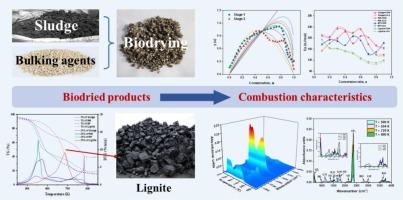污泥生物干燥产物的燃烧动态特性
IF 7.5
1区 工程技术
Q2 ENERGY & FUELS
引用次数: 0
摘要
生物干燥依靠内源生物热驱动除水,因其节能环保而受到广泛关注,生物干燥产物(BP)被认为是一种碳中和的可再生燃料,为污水污泥管理提供了一种可持续的策略。然而,对BP的燃烧行为还没有充分的表征。本研究旨在通过动力学分析来评价BP的燃烧特性,特别关注膨化剂(玉米芯)和生物降解的协同效应。结果表明,填充剂增强了低活化能(Ea)的挥发性排放。生物降解促进了木质纤维素的分解,增加了固定碳的形成,并扩大了燃烧温度范围(523.9-781.0 K)。与原料(污泥和玉米芯的混合物)相比,BP具有更高的燃烧指数和热值(13.15 MJ/kg湿基)。动力学分析表明,BP燃烧符合反应模型(n = 1.5)阶,平均Ea值降低(177.83 kJ/mol)。生物降解还减少了BP燃烧过程中SO2、NO和不饱和碳化合物的排放。总体而言,填充剂和生物降解的协同作用显著提高了污泥源BP的燃烧性能,突显了它们作为清洁可再生垃圾源燃料的潜力。本文章由计算机程序翻译,如有差异,请以英文原文为准。

Combustion dynamic characteristics of biodried products derived from sewage sludge biodrying
Relying on endogenous bio-heat driving water removal, biodrying has garnered wide attention for its energy efficiency and environmental friendliness, and the biodried product (BP) is recognized as a carbon–neutral and renewable fuel, which offers a sustainable strategy for sewage sludge management. However, the combustion behaviors of BP remain inadequately characterized. This study aimed to evaluate the combustion characteristics of BP through kinetic analysis, with special focus on the synergistic effects of bulking agent (corncob) and biodegradation. The results indicated that bulking agent enhanced volatile emissions with low activation energy (Ea). Biodegradation promoted lignocellulose decomposition, increased fixed carbon formation, and broadened the combustion temperature range (523.9–781.0 K). Compared to raw materials (the mixtures of sludge and corncob), BP exhibited higher combustion indices and calorific value (13.15 MJ/kg wet basis). Kinetic analysis indicated that BP combustion followed the Order of reaction model (n = 1.5), with a reduced average Ea value (177.83 kJ/mol). Biodegradation also decreased the emissions of SO2, NO, and unsaturated carbon compounds during BP combustion. Overall, the synergistic effects of bulking agent and biodegradation significantly improved the combustion performance of sludge-derived BP, highlighting their potential as clean and renewable refuse-derived fuels for energy recovery.
求助全文
通过发布文献求助,成功后即可免费获取论文全文。
去求助
来源期刊

Fuel
工程技术-工程:化工
CiteScore
12.80
自引率
20.30%
发文量
3506
审稿时长
64 days
期刊介绍:
The exploration of energy sources remains a critical matter of study. For the past nine decades, fuel has consistently held the forefront in primary research efforts within the field of energy science. This area of investigation encompasses a wide range of subjects, with a particular emphasis on emerging concerns like environmental factors and pollution.
 求助内容:
求助内容: 应助结果提醒方式:
应助结果提醒方式:


